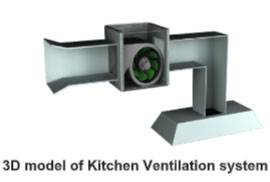The Importance of Kitchen Ventilation and Why Ventilation is as Important as the Cleanliness
The kitchen is the heart of any residential home or commercial restaurant. It is a gathering place for families and friends as well as professional cooking teams who spend hours of their time in the space to prepare meals that bring people together. Residents of Dubai, Abu Dhabi, Sharjah, and other parts of the Middle East rely on LPG and natural gas for their daily needs.
The combustion of LPG/Natural gas stoves in the kitchen emits toxic gases such as nitrogen dioxide (NO2), formaldehyde (CH2O), and carbon monoxide (CO), which are easily inhaled, deposited in the lungs, and absorbed into the blood. This is further complicated by masking odours through various foods when cooked, that emit similar smells as those emitted by gas burners.
Each year, exposure to such indoor pollutants causes premature deaths due to pneumonia, heart disease, and other respiratory illnesses. It’s a tragic and terrifying reminder of the inherent dangers of indoor cooking and the importance of proper kitchen ventilation.

Typically, in well ventilated residential and commercial kitchens, fumes generated by cooking are captured by the kitchen hood and exhausted through the ducting systems. However, improper ventilation can
Kitchen Ventilation System Issues:
There are various problems that limit the effectiveness of a kitchen hood:
- Wrong size and type of kitchen hoods: Many kitchen hoods aren’t large enough to cover the effective range of a cooking stove, resulting in smoke air leakage from kitchen areas to outside areas.
- Wrong fan airflow design and selection: If the fan design is incorrect or on the lower side, it will not extract all of the smoke air from the kitchen, resulting in another leakage.
- Cooking smells and oil accumulation: The main cause of cooking smells and oil accumulation on the cooking surface is an insufficient kitchen ventilation system. Unfortunately, no matter how little or how much you cook, unpleasant cooking odours will remain in your kitchen.
Tips for Choosing the Best Kitchen Hood and Fan
You can significantly improve indoor air quality by choosing the right type of kitchen hood, ventilation fans, and using them correctly.
Here are some solutions for a kitchen ventilation system:
- Look for a Kitchen Hood that completely covers the cooking surface: The perfect size is 3″ longer than the Kitchen surface range on each side of the Kitchen hood.
- Choose the fan that will cover the air changes required in the kitchen: Create an airflow requirement for your kitchen system based on the length, width, and distance between the hood surface and the cooking stove.
A few simple cooking techniques will also improve the air quality in your kitchen. Clean the oil accumulated on the hood surface area on a regular basis to improve ventilation. Always turn on the kitchen exhaust system when cooking.
Installing and using the proper type of kitchen hood and extract fan will help to reduce indoor air pollution, which is important for our health and safety. We spend up to 90% of our time indoors, and we unknowingly breathe in a significant amount of pollution.
References
